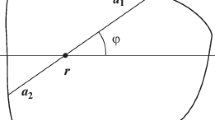Abstract
Once a subscriber unit served by a microcell initiates a call, it must remain in the coverage area of the microcell long enough to complete call set up and hand-off functions. This restricts the minimum size attainable by a microcell. This paper derives the relationship between the microcell size, the call processing time, and the probability that a subscriber unit, initiating a call, will remain inside the microcell coverage area for at least the duration of call processing. Under simple assumptions, time spent in the coverage area of the microcellbefore andafter call initiation have the same cumulative density function, which is derived in this paper for traffic conditions encountered in highway and metropolitan settings.
Similar content being viewed by others
References
AT & TNSI, ETSI GSM2 Standards Contribution (Sept. 1991).
M. Benveniste, Cell selection in two-tier microcellular/macrocellular systems, ETSI GSM2 Standards Contribution (May 1992).
Unitel, Idle mode cell reselection for microcells, ETSI GSM2, Ronneby, Sweden (17–20 September 1991).
M. Benveniste, Method and apparatus for increasing two tier macrocell/microcell subscriber capacity in a cellular system in which microcell access by a mobile is dependent on a mobile's vehicular speed, U.S. Patent #5,345,499 (9 Sept. 1994).
Author information
Authors and Affiliations
Additional information
This paper is based on a contribution to the ETSI GSM2 Standards, Ronneby, Sweden, September 1991 [1].
Rights and permissions
About this article
Cite this article
Benveniste, M. Probability models of microcell coverage. Wireless Netw 2, 289–296 (1996). https://doi.org/10.1007/BF01262048
Issue Date:
DOI: https://doi.org/10.1007/BF01262048




